uni-app组件知识记录
style标签的lang
<template>
<view class="content">
<h1 class="test"><span class="test1">我</span></h1>是谁
</view>
</template>
<style lang="scss">
.content {
// content中允许定义下个层级标签或多层级中的样式,不能定义同级标签或者样式
.test1 {
background-color: red;
}
// h1和 test属于同级则不生效
h1 {
.test {
background-color: red;
}
}
}
</style>
scss是css样式增强版定义
样式中可以嵌套,标签或者class定义

视图容器
组件scroll-view的使用(滚动)
<template>
<view class="content">
<!-- 左右上下滑动 -->
<scroll-view class="scroll" scroll-x="true">
<image class="item" src="../../static/img/小猫测试.jpeg">
</image>
<image class="item" src="../../static/img/小猫测试.jpeg">
</image>
<image class="item" src="../../static/img/小猫测试.jpeg">
</image>
</scroll-view>
</view>
</template>
<style lang="scss">
.content {
.scroll {
// scroll标签中内容不换行
white-space: nowrap;
.item {
width: 300rpx;
height: 200rpx;
margin-right: 1rpx;
// 在父级的标签中排列一行,超过父级宽度则在下一行
display: inline-block;
}
}
}
</style>

组件swiper的使用(轮播)
<swiper indicator-dots class="swiper">
<swiper-item>
<image class="swiper-image" src="/static/img/小猫测试.jpeg" mode="aspectFill"></image>
</swiper-item>
<swiper-item>
<image class="swiper-image" src="/static/img/小猫测试.jpeg" mode="aspectFill"></image>
</swiper-item>
<swiper-item>
<image class="swiper-image" src="/static/img/小猫测试.jpeg" mode="aspectFill"></image>
</swiper-item>
</swiper>
.swiper {
height: 300rpx;
.swiper-image {
height: 300rpx;
width: 750rpx;
}
}
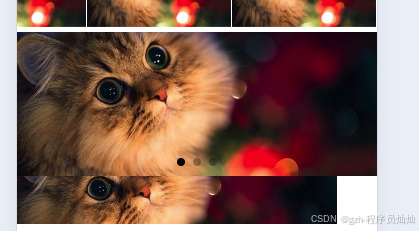
媒体组件
组件image的使用(图片)
<view>
<image class="image-t" src="/static/img/小猫测试.jpeg" mode="aspectFill"></image>
</view>
aspectFill: 始终保持宽或者高全部展示
当容器image的宽度小于图片宽度时,图片高度完全展示,当容器image的高度小于图片高度时,图片宽度完全展示
图片: 320px 240px
.image-t {
width: 200px;
// height: 300px;
}
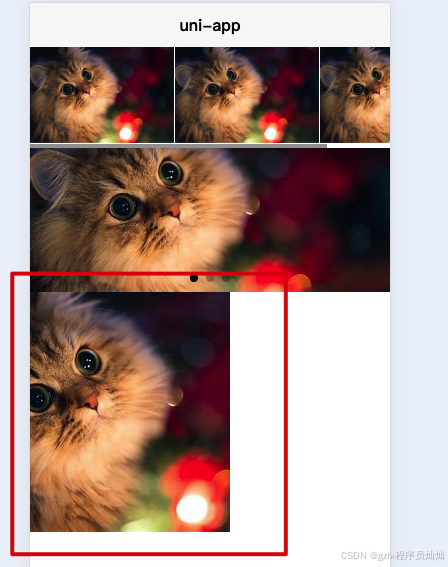
路由与页面跳转
navigator
<navigator url="/pages/list/list">跳转到list页面(保留历史页面,左上角有返回按钮)</navigator>
<navigator url="/pages/list/list" open-type="redirect">跳转到list页面,打开新页面,左上角没有返回按钮</navigator>
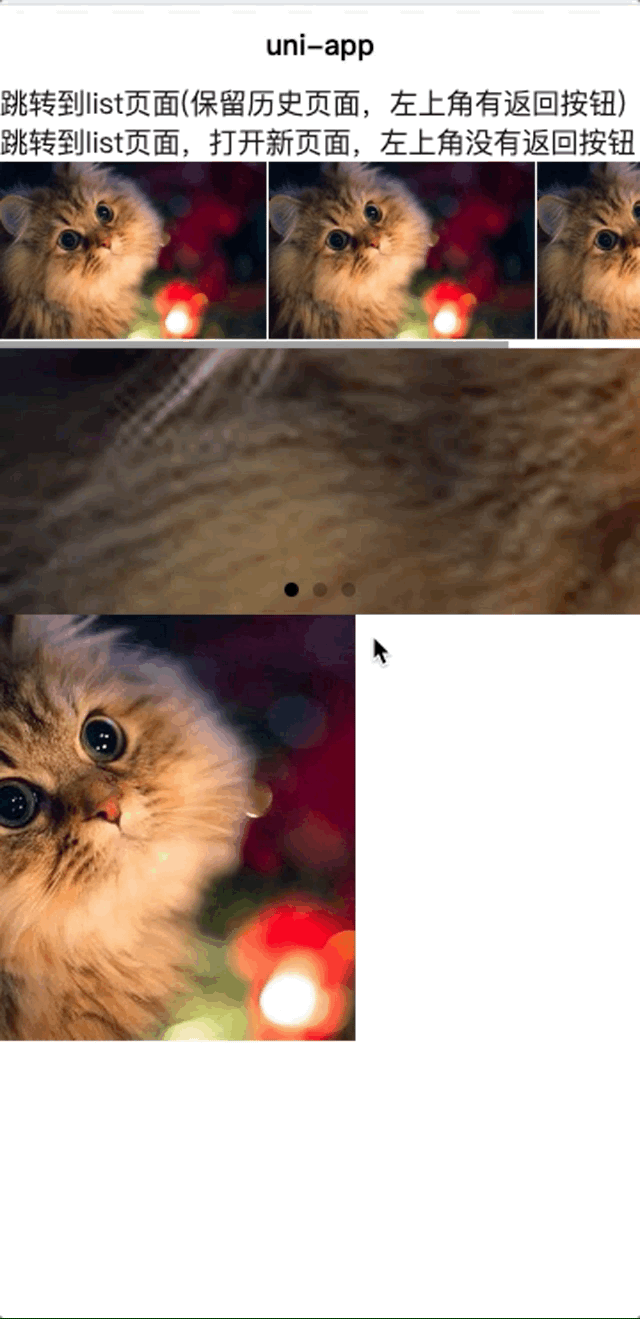
navigate: 保留历史页面,可以跳转到非 tabBar 的页面的路径
redirect: 不保留历史页面打开新页面,不可跳转到非tabBar页面路径
switchTab: url不能携带参数
reLaunch: url可以携带参数,可以跳转到非 tabBar 的页面的路径但不能带参数
tabBar底部导航配置
{ "tabBar": {
"color": "#7A7E83",
"selectedColor": "#3cc51f",
"borderStyle": "black",
"backgroundColor": "#ffffff",
"list": [{
"pagePath": "pages/index/index",
"text": "首页"
},
{
"pagePath": "pages/list/list",
"text": "列表"
}
]
}
}
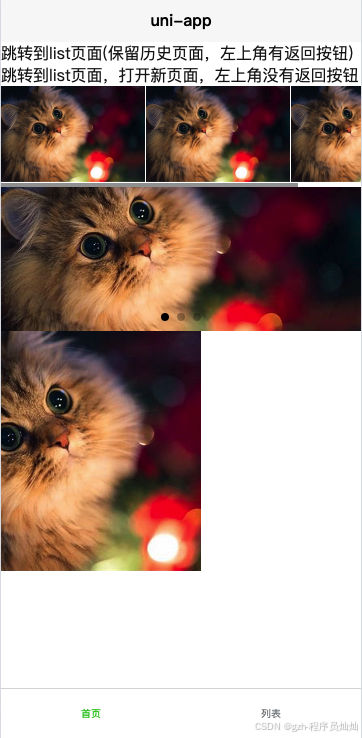
表单提交
<template>
<view>
<form @submit="toSubmmit">
<view class="name row">
<input type="text" name="username">
</view>
<view class="desc row">
<textarea name="content"></textarea>
</view>
<view class="row">
<radio-group name="gender">
<label>
<radio value="1" /><text>男</text>
</label>
<label>
<radio value="0" /><text>女</text>
</label>
<label>
<radio value="2" checked /><text>保密</text>
</label>
</radio-group>
</view>
<view class="row">
<picker :range="options" name="address" :value="selectedAddress" @change="selectedName">
地址: {{options[selectedAddress]}}
</picker>
</view>
<view class="row">
<button form-type="submit" type="primary">提交表单</button>
<button form-type="reset">重置表单</button>
</view>
{{form}}
</form>
</view>
</template>
<script>
export default {
data() {
return {
form: null,
options: ['北京', '上海', '广州', '深圳'],
selectedAddress: 2
}
},
methods: {
toSubmmit(e) {
console.log(e.detail.value);
this.form = e.detail.value
},
selectedName(e) {
this.selectedAddress = e.detail.value;
}
}
}
</script>
<style lang="scss">
.name {
border: 1px solid #000000;
padding: 10rpx;
}
.desc {
border: 1px solid #000000;
// 内边距
padding: 10rpx;
}
.row {
margin-bottom: 10rpx;
}
</style>
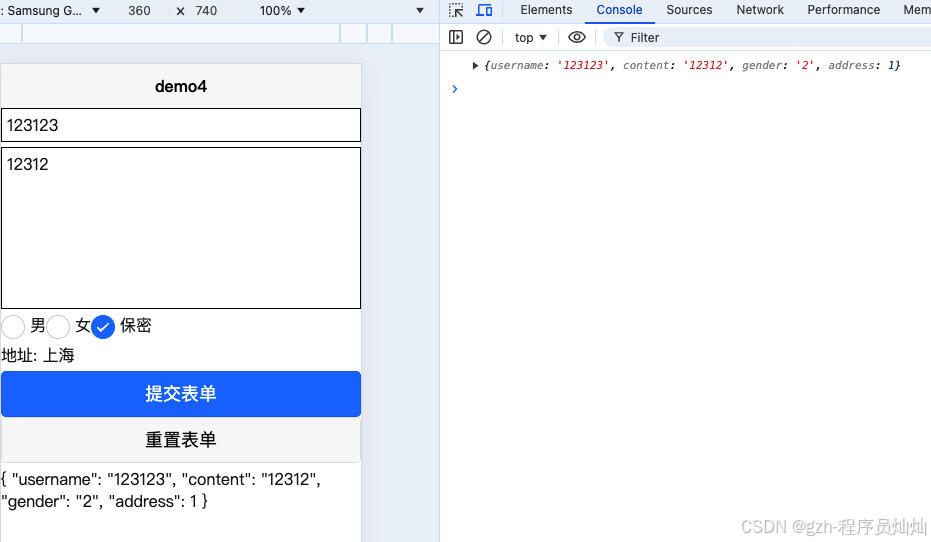
提交表单三个条件:
1.标签中添加name
2.button添加form-type='submit'
3.form标签添加提交事件方法
组件
根目录下在components目录下创建组件文件夹,符合‘components/组件名称/组件名称.vue’目录结构
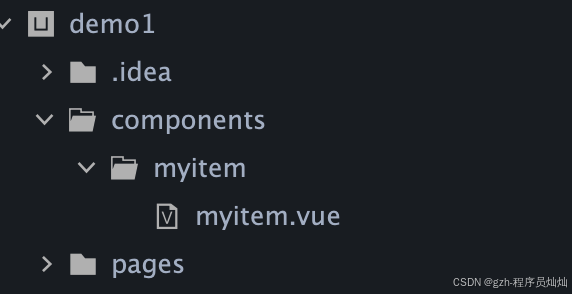
<template>
<view>
<view class="block">自定义组件</view>
</view>
</template>
<script>
export default {
name: "myitem",
data() {
return {
};
}
}
</script>
<style lang="scss">
.block {
width: 100%;
height: 200rpx;
background-color: red;
// 居中
display: flex;
justify-content: center;
align-items: center;
}
</style>
引入组件myitem
<myitem></myitem>

动态赋值子组件的属性字段props
props 可以是数组或对象,用于接收来自父组件的数据
新闻标题组件
<template>
<view>
<view class="pub-title">
<view class="first">{{title}}</view>
<view class="second">新闻二标题</view>
<view class="line"></view>
<view>组件中data属性:{{commonData}}</view>
<view>组件中data属性随机值只加载一次:{{randomNum}}</view>
<view>组件中数组类型:{{list}}</view>
<view>组件中Object类型:{{obj}}</view>
</view>
</view>
</template>
<script>
export default {
props: {
title: {
type: String,
// 属性默认值
default: '新闻大标题'
},
subTitle: {
type: String,
default: '新闻二标题'
},
// 数组字段必须使用function返回
list: {
type: Array,
default: function() {
return [1, 2, 3]
},
},
// 对象字段必须使用function返回
obj: {
type: Object,
default: function() {
return {
name: '张三',
age: 18
}
}
}
},
data() {
return {
"commonData": "初始化commonData",
"randomNum": Math.random().toFixed(2)
}
}
}
</script>
<style lang="scss">
.pub-title {
background-color: #FFEAC5;
display: flex;
flex-direction: column;
align-items: center;
justify-content: center;
margin: 30rpx 0;
.first {
font-size: 40rpx;
font-weight: bold;
margin-right: 10rpx;
}
.second {
font-size: 30rpx;
color: #666;
margin-right: 10rpx;
}
.line {
width: 80rpx;
height: 5rpx;
background-color: #666;
border-radius: 2rpx;
margin-top: 20rpx;
}
}
</style>
使用组件
<!-- 把newBigTitle值赋值给组件的title属性 -->
<pub-title :title="newBigTitle"></pub-title>
export default {
data() {
return {
newBigTitle: "demo4新闻大标题"
}
}
}

1.组件中定义props属性字段
2.组件中使用props属性
3.引入组件,赋值props属性值
组件中的数组类型和Object类型,必须使用function函数返回。
VUE语法
data 属性
data 必须声明为返回一个初始数据对象的函数(注意函数内返回的数据对象不要直接引用函数外的对象);否则页面关闭时,数据不会自动销毁,再次打开该页面时,会显示上次数据。
data: 初始化页面属性值
//正确用法,使用函数返回对象
data() {
return {
title: 'Hello'
}
}
//错误写法,会导致再次打开页面时,显示上次数据
data: {
title: 'Hello'
}
//错误写法,同样会导致多个组件实例对象数据相互影响
const obj = {
title: 'Hello'
}
data() {
return {
obj
}
}
数据不会自动销毁,再次打开该页面时,会显示上次数据
<view>data属性随机值只加载一次:{{randomNum}}</view>
export default {
data() {
return {
"randomNum": Math.random().toFixed(2)
}
}
}
刷新页面重新加载

指令
v-if/v-else
<view v-if="state">显示</view>
<!-- v-else必须在v-if下面 -->
<view v-else>不显示</view>
data() {
return {
title: 'Hello',
state: true
}
},
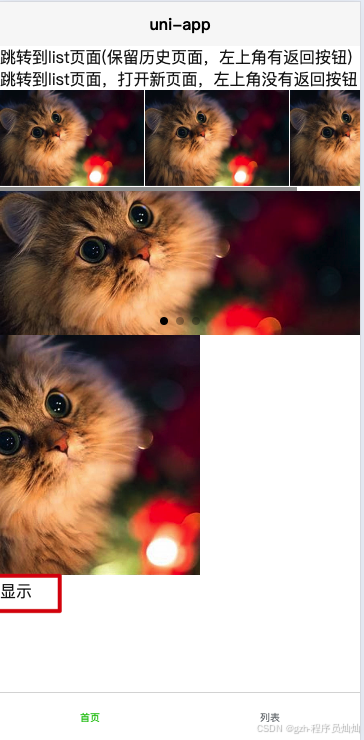
v-show
<view v-if="state">显示</view>
<view v-else>1</view>
<view v-show="state">v-show展示</view>
<view v-show="!state">v-show不展示</view>
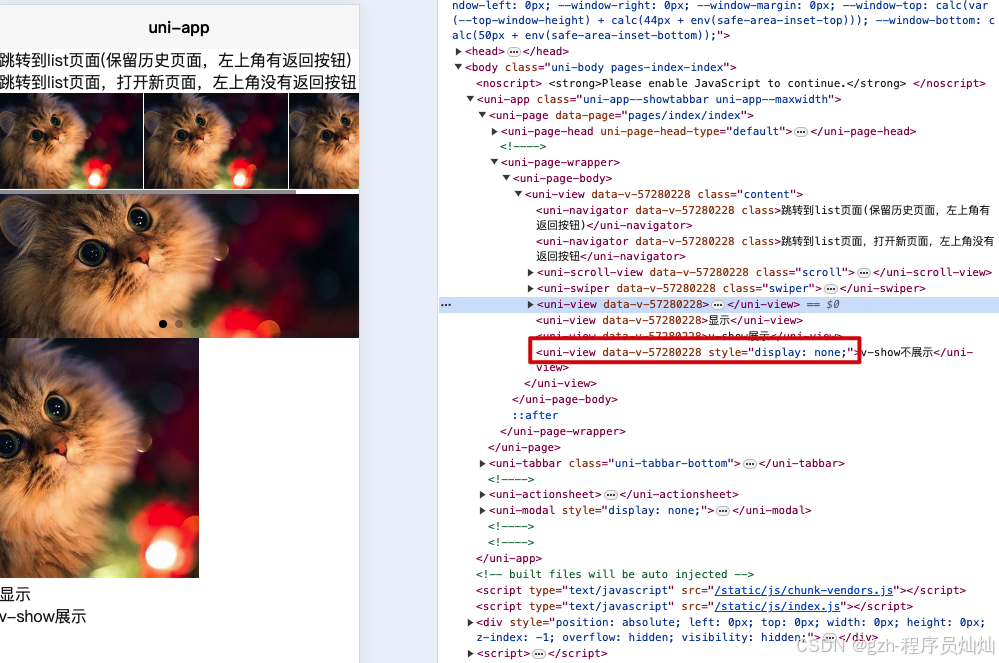
v-show: 通过判断属性值真假,使用css样式控制内容是否显示
v-for循环
<view v-for="(item,index) in products" :key="index">
<view>产品:{{item.name}} {{index}}</view>
<view>价格:{{item.price}} {{index}}</view>
</view>
<view v-for="(value,key,index) in forObject">
<view>{{key}}: {{value}},脚标: {{index}}</view>
</view>
export default {
data() {
return {
title: 'Hello',
state: true,
products: [{
name: "好物",
price: "20.18"
},
{
name: "好物1",
price: "20.19"
},
forObject: {
name: "张三",
age: "29"
}
]
}
}
}
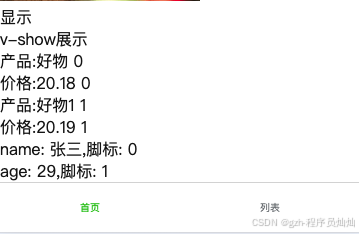
<view class="test-for" v-for="index in 3">
<image :src="image"></image>
</view>
v-for会遍历
v-html标签
<!-- 解析html标签 -->
<view v-html="title"></view>
<view v-html="htmlStr"></view>
htmlStr: "<h1>Hello</h1>",
title: 'Hello',

v-bind动态绑定
v-bind: 动态绑定组件中的属性值
<view>
<!-- v-bind缩写 -->
<image :src="image" mode=""></image>
</view>
image: "/static/img/小猫测试.jpeg",
v-on 指令
指的是事件
<view v-on:click="onlickOn">
{{title}}
</view>
<!-- 缩写 -->
<view @click="onlickOn">
{{title}}
</view>
class与style绑定
<view class="box" :style="{background: bgcolor}"></view>
export default {
data() {
return {
bgcolor: "#000"
}
}
}
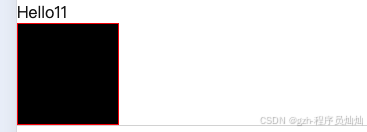
<!-- 动态使用类样式 -->
<view class="box" :class="{myclass: state}"></view>
export default {
data() {
return {
state: true
}
}
}
.myclass{
width: 200rpx;
height: 200rpx;
border: 1rpx solid red;
background: blue;
}
.box {
width: 200rpx;
height: 200rpx;
border: 1rpx solid red;
background: red;
}

动态指定myclass生效,背景色为蓝色,但仍被box样式覆盖了。说明动态指定的样式优先级低于静态样式的
使用三元表达式使类样式生效
<view class="static" v-bind:class="[isActive ? activeClass : '', errorClass]">222</view><!-- 三元表达式 -->
导航栏高亮显示
默认首页tab背景色红色,选中tab背景色变为红色,其他tab无背景色
<view class="nav">
<view class="item" :class="activeIndex!=index ? '' : 'active'" v-for=" (item,index) in navs" :key="index"
@click="activeNav(index)">
{{item.name}}
</view>
</view>
export default {
data() {
return {
activeIndex: 0,
navs: [{
name: "首页"
},
{
name: "介绍"
},
{
name: "产品"
},
]
}
},
methods: {
activeNav(index) {
this.activeIndex = index;
}
}
}
.nav {
// 子标签内容展示在同一行
display: flex;
.item {
// 使view的宽度在父标签中平均分布
flex: 1;
// 内容行间距,可以让内容垂直居中
line-height: 100rpx;
// 水平居中
text-align: center;
&.active {
background-color: red;
}
}
}
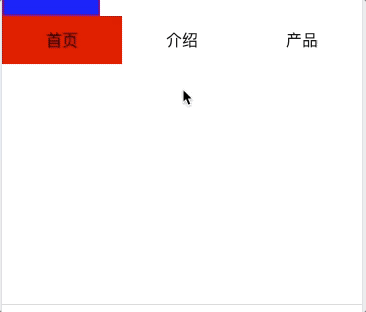
v-model双向绑定
<template>
<view>
<view @click="changeInput">
标题: {{title}}
</view>
<input class="text" v-model="title" />
</view>
</template>
<script>
export default {
data() {
return {
title: '双向绑定',
}
},
methods: {
changeInput() {
this.title = '改变后的标题'
}
}
}
</script>
<style lang="scss">
.text {
width: 100%;
height: 100rpx;
border: 1px solid #000;
}
</style>
双向绑定: 修改input值,data属性值跟着改变,修改data属性值,input值也会改变。

v-model示例
<view class="out">
<view class="row">
<input class="border" type="text" placeholder="请输入姓名" v-model="message.name">
</view>
<view class="row">
<input class="border" type="text" placeholder="请输入电话" v-model="message.mobile">
</view>
<view class="row">
<textarea class="border" placeholder="请输入内容" v-model="message.content"></textarea>
</view>
<button type="primary">提交</button>
{{message}}
</view>
message: {
name: '',
mobile: '',
content: ''
}
.out {
padding: 30rpx;
.row {
margin-bottom: 20rpx;
}
.border {
width: 100%;
// 四个边填充10rpx
padding: 10rpx;
border: 1px solid #000;
// 内填充
box-sizing: border-box;
// 设置圆角
border-radius: 10rpx;
}
}

计算属性和侦听器
计算属性computed
<view>
{{ message.split('').reverse().join('') }}
</view>
在模板中绑定表达式是非常便利的,但是它们实际上只用于简单的操作。在模板中放入太多的逻辑会让模板过重且难以维护,这里是想要显示变量 message 的翻转字符串。当你想要在模板中多包含此处的翻转字符串时,就会更加难以处理。
所以,对于任何复杂逻辑,你都应当使用计算属性。计算属性完全可以使用方法代替,区别在于计算属性存在缓存,对于加载不变数据计算属性性能高于方法。
<view>
<!-- 使用方法 -->
第一次加载计算属性computeTitle值: {{computeTitle}}
<br>
第二次加载计算属性computeTitle值: {{computeTitle}}
<br>
第一次加载方法computeTitle值: {{computeTitleMethod()}}
<br>
第二次加载方法computeTitle值: {{computeTitleMethod()}}
</view>
methods: {
computeTitleMethod() {
return Math.random();
}
},
computed: {
computeTitle() {
return Math.random();
}
}

子组件触发自定义事件传递给父组件
子组件my-event
<input type="text" placeholder="请输入" @input="onInput" />
methods: {
onInput(e) {
// 使用emit向父组件传递数据
console.log("子组件输入值:" + e.detail.value);
this.$emit('customEventName', e.detail.value)
}
}
引入my-event
<!-- 引用子组件传值 -->
<my-event @customEventName="inputValue"></my-event>
methods: {
inputValue(e) {
console.log("父组件接收值:" + e);
}
}
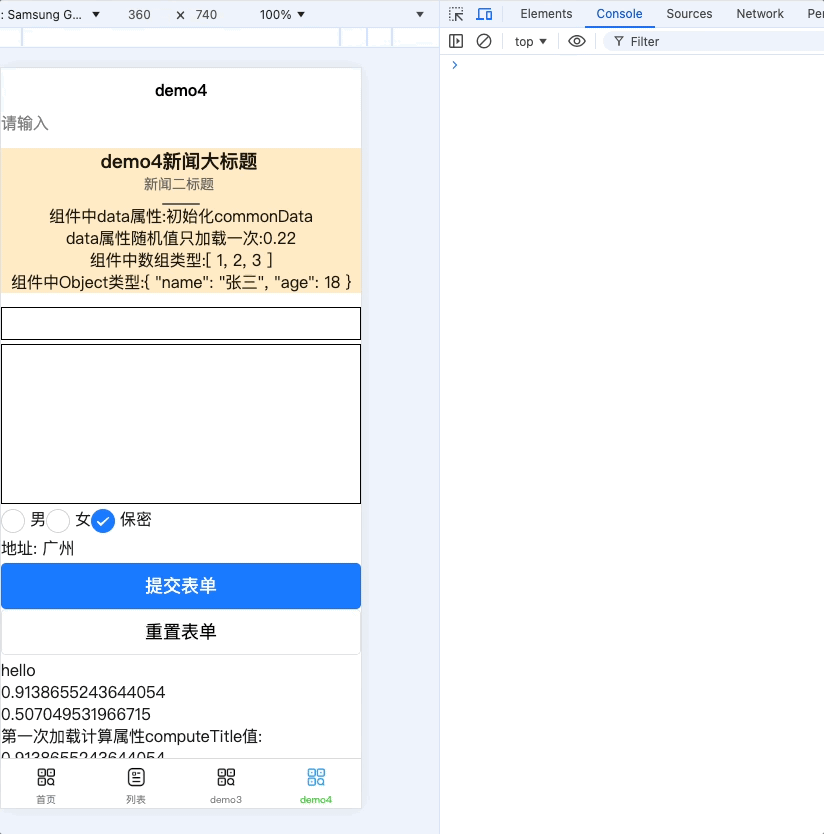
- 子组件自定义事件名称
- 父组件引入子组件
- 父组件使用子组件定义的事件名称
- 子组件触发事件传递到父组件
父组件引入子组件时,如果使用原生事件,需要指定事件为本地事件
如:
<my-event @customEventName="inputValue" @clink.native="onClick"></my-event>
在使用子组件的同时,使用原生事件click,指定.native标识。
将原生事件绑定到组件
使用.native修饰符,进行修饰原生组件。
<my-event @customEventName="inputValue" @clink.native="onClick"></my-event>
子组件向上传值案例
实现弹窗隐藏的功能
子组件my-pop弹窗
<template>
<view>
<!-- 弹出层 -->
<view class="box" :hidden="hiddenStatus">
<view class="row">
<view class="pop">弹窗内容</view>
</view>
<view class="row">
<button @click="shut">关闭</button>
</view>
</view>
</view>
</template>
<script>
export default {
name: "my-pop",
data() {
return {
};
},
props: {
hiddenStatus: {
type: Boolean,
default: false
}
},
methods: {
shut() {
this.$emit('shut');
}
},
}
</script>
<style lang="scss">
.box {
background-color: #000000;
opacity: 0.5;
position: fixed;
top: 0;
left: 0;
// 屏蔽父页面不可点击
z-index: 999;
// 屏蔽父页面滚动
height: 100%;
width: 100%;
.row {
display: flex;
justify-content: center;
align-items: center;
.pop {
width: 300rpx;
height: 200rpx;
background-color: #FFFFFF;
border-radius: 10rpx;
text-align: center;
line-height: 300rpx;
font-size: 40rpx;
margin-top: 80%;
}
button {
height: 100rpx;
background-color: #000000;
border-radius: 10rpx;
color: #FFFFFF;
}
}
}
</style>
父组件引入
<!-- 弹出框 -->
<view>
<button @click="showPopStatusClick">点击弹出框</button>
<my-pop :hiddenStatus="hiddenPop" @shut="shutPop"></my-pop>
</view>
data() {
return {
hiddenPop: true
}
},
methods: {
showPopStatusClick() {
this.hiddenPop = false
},
shutPop(e) {
this.hiddenPop = true
}
}
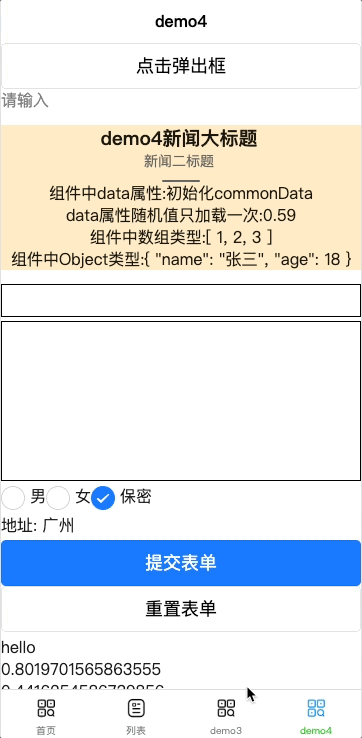
- 父组件默认弹窗隐藏
- 父组件点击事件显示弹窗
- 子组件弹窗触发自定义关闭事件
- 父组件接收事件,关闭弹窗
.sync 修饰符
当一个子组件改变了一个 prop 的值时,这个变化也会同步到父组件中所绑定。 .sync 它会被扩展为一个自动更新父组件属性的 v-on 监听器
使用sync修饰符,通过修改子组件的props可以修改父组件的属性值,因此在上面的案例中,可以通过修改子组件的hiddenStatus值,从而修改父组件的hiddenPop值。
<!-- <my-pop :hiddenStatus="hiddenPop" @shut="shutPop"></my-pop> -->
<!-- 这里不再需要点击事件修改hiddenPop值,而是通过sync修饰,把父组件的hiddenPop和子组件的hiddenStatus属性进行绑定 -->
<my-pop :hiddenStatus.sync="hiddenPop"></my-pop>
子组件修改
export default {
props: {
hiddenStatus: {
type: Boolean,
default: true
}
},
methods: {
shut() {
// 子组件修改绑定值格式为update:hiddenStatus,从而修改了父组件的hiddenPop值
this.$emit('update:hiddenStatus', true);
}
},
}
- 父组件使用.sync修改子组件hiddenStatus属性,从而绑定父组件的hiddenPop值
- 子组件自定义触发事件,事件名格式为
update:子组件属性值 - 通过子组件修改hiddenStatus值,从而修改了父组件的hiddenPop值
- 父组件监听hiddenPop改变,动态赋值子组件props属性值,使得父组件的hiddenPop值和子组件的hiddenStatus值相同
sync修饰作用就像v-model双向绑定,只是作用在父子组件之间。
vue的生命周期

App.vue中的方法
export default {
// 刷新页面会执行
onLaunch: function() {
console.log('App Launch')
},
// 刷新页面会执行,屏幕显示页面会执行,如,浏览器查看其他标签,然后切换回该标签
onShow: function() {
console.log('App Show')
},
// 屏幕隐藏页面会执行,如,浏览器查看其他标签
onHide: function() {
console.log('App Hide')
}
}
API使用
路由跳转页面
<view>
<button @click="toTabBar()">使用api跳转到tabbar页面demo3</button>
</view>
toTabBar() {
// 使用switchTab方法跳转到底部tabbar页面
uni.switchTab({
url: "/pages/demo3/demo3"
})
}
页面返回
back() {
// 只会返回通过navigateTo打开的页面
uni.navigateBack();
}
携带参数跳转页面传参
takeParamToView() {
uni.navigateTo({
url: "/pages/list/list?name=张三&age=18"
})
}
list页面使用onLoad函数接收
onLoad(e) {
console.log(e)
}

界面
下方弹出菜单
data() {
return {
title: 'Hello',
list: ["三国演义", "西游记", "红楼梦"]
}
},
onLoad() {
// 下方弹出操作菜单,可自定义菜单内容
uni.showActionSheet({
itemList: this.list,
success: res => {
console.log(this.list[res.tapIndex]);
}
});
},

设置导航条
onLoad() {
// 设置导航条
uni.setNavigationBarTitle({
title: '导航标题'
})
}

设置TabBar
使用iconfont图标
下载ttf文件:选中将要使用的图标添加到购物车,把购物车中的图标添加到自己的项目中

打开我的项目下载ttf文件,放到到开发项目的static目录下


代码中使用图标,复制代码,把&#x替换为\u
"tabBar": {
"iconfontSrc": "static/iconfont/iconfont.ttf",
"list": [{
"pagePath": "pages/index/index",
// 小程序暂不支持iconfont
"iconfont": {
"text": "\ue60e"
},
"text": "首页"
},
{
"pagePath": "pages/demo1/demo1"
}
]
}

动态设置 tabBar 某一项的内容
uni.setTabBarItem({
index: 0,
text: '文案'
})

为 tabBar 某一项的右上角添加文本。
onLoad() {
uni.setTabBarBadge({
index: 1,
text: "1"
})
}

网络
发起请求
<view class="">
<button @click="showPic">换一张</button>
<image :src=pic mode="aspectFill" style="width: 100%;"></image>
</view>
methods: {
showPic() {
uni.showLoading({
title: "加载中"
})
uni.request({
url: 'https://api.thecatapi.com/v1/images/search?limit=1',
method: 'GET',
success: res => {
console.log(res);
this.pic = res.data[0].url;
console.log(this.pic);
uni.hideLoading();
}
})
}
},

新闻文章案例
列表页面
<template>
<view>
<view class="out">
<view class="row" v-for="item in list" :key="item.id" @click="detail(item.id)">
<view class="title">{{item.title}}</view>
<view class="content">{{item.body}}</view>
</view>
</view>
</view>
</template>
<script>
export default {
data() {
return {
"list": [],
}
},
methods: {
getList() {
uni.showLoading({
title: "加载中"
});
uni.request({
url: 'http://jsonplaceholder.typicode.com/posts',
method: 'GET',
success: res => {
this.list = res.data;
}
});
uni.hideLoading();
},
detail(id) {
console.log(id);
uni.navigateTo({
url: '/pages/detail/detail?id=' + id
});
}
},
onLoad() {
this.getList();
}
}
</script>
<style lang="scss">
.out {
padding: 20rpx;
.row {
border-bottom: 1rpx solid #d7d9df;
.title {
font-size: 36rpx;
font-weight: bold;
margin-bottom: 20rpx;
}
.content {
font-size: 30rpx;
color: #666666;
margin-bottom: 15rpx;
}
}
}
</style>
<template>
<view>
<view class="detail">
<view class="detail-title">{{articleDetail.title}}</view>
<view class="detail-content">{{articleDetail.content}}</view>
</view>
<view class="comments">
<text class="comment-title">评论</text>
<view class="comment" v-for="item in commentsList" :key="item.id">
<view class="comment-top">
<view class="comment-name">{{item.name}}</view>
<view class="comment-email">{{item.email}}</view>
</view>
<view class="comment-content">{{item.body}}</view>
</view>
</view>
</view>
</template>
<script>
export default {
data() {
return {
id: 0,
articleDetail: {
id: 0,
title: '',
content: '',
},
commentsList: [{
name: '',
email: '',
body: ''
}, ]
}
},
methods: {
detail() {
uni.request({
url: 'http://jsonplaceholder.typicode.com/posts/' + this.articleDetail.id,
success: (res) => {
this.articleDetail.title = res.data.title;
this.articleDetail.content = res.data.body;
}
})
},
comments() {
uni.request({
url: `https://jsonplaceholder.typicode.com/posts/${this.articleDetail.id}/comments`,
success: (res) => {
this.commentsList = res.data;
}
})
}
},
onLoad(e) {
this.articleDetail.id = e.id;
this.detail();
this.comments();
}
}
</script>
<style lang="scss">
.detail {
width: 100%;
padding-bottom: 20rpx;
.detail-title {
text-align: center;
font-size: 40rpx;
font-weight: bold;
padding: 20rpx;
}
.detail-content {
width: 100%;
box-sizing: border-box;
background-color: #c8dcd6;
}
}
.comments {
padding: 30rpx;
background-color: #f5f5f5;
.comment-title {
font-size: 40rpx;
font-weight: bold;
}
.comment {
margin-top: 20rpx;
font-size: 30rpx;
border-bottom: 1rpx solid #d7d9df;
.comment-top {
display: flex;
justify-content: space-between;
color: #999;
}
}
}
</style>

问题
图片遮住其他内容

解决方法:
z-index 较大的重叠元素会覆盖较小的元素
对导航栏样式设置: z-index: 10;
vue中返回false场景
false:布尔值 false 自然是假值。
0:数字 0 被视为假值。
""(空字符串):空字符串被视为假值。
null:空值 null 被视为假值。
undefined:未定义值 undefined 被视为假值。
NaN:非数字值 NaN(Not-a-Number)被视为假值。
接口QPS小,频繁请求导致500的问题
getNavData和getNews调用后端接口,由于接口的QPS为1,两个方法为异步请求,导致getNews中调用接口500,在调用getNavData后,睡眠1.5s然后执行getNews方法,避免QPS小的问题
onLoad() {
this.news = [];
this.getNavData();
setTimeout(() => {
this.getNews();
}, 1500)
},
开发新闻应用



